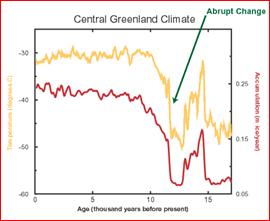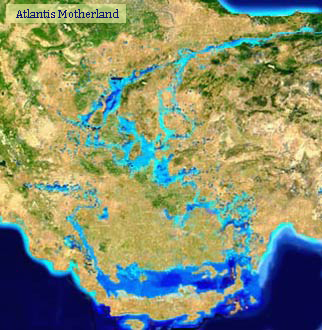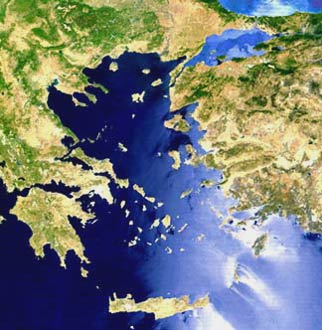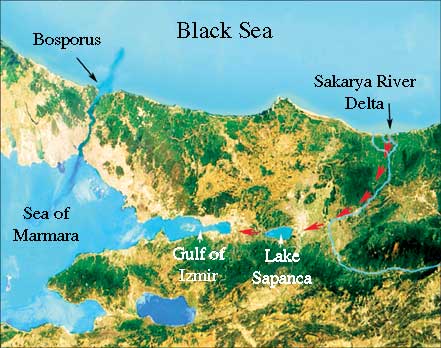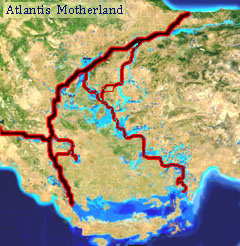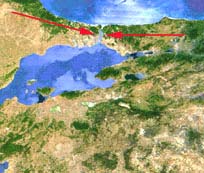 |
THE GREAT
ATLANTIS FLOOD:
one
terrible day and night of misfortune;
the
extraordinary inundation of Atlantis, Attica and Hellas
By Leon Flying Eagle
& Mary Whispering Wind
_________________________________________________
Introduction
to Great Atlantis Flood Theory
The Great Atlantis Flood Theory presents scientific evidence which supports the truth of the history of Atlantis, as recorded in the Dialogues of Plato. According to the Dialogues, the history of Atlantis, Attica and Hellas was recorded in ancient sacred Egyptian records. The Dialogues reveal that an aged Egyptian priest showed these records to a visiting Greek statesman named Solon, known as the wisest of the Seven Greek Sages and “Lawgiver” of Athens. Solon translated the records and wrote an unfinished epic poem containing all the details of these ancient civilizations. This poem was subsequently recited by Critias and recorded in The Dialogues of Plato. The Dialogues affirm that these historical records are not fiction but are indeed fact, and that the perseverance, tragedies and triumphs of the inhabitants of these ancient nations, as revealed in the records, are absolutely true! The Egyptian priest described the founding of ancient Atlantis by Poseidon and Cleito and the founding of ancient Athens by Hephaestus and Athene, at some date which was lost in antiquity. Many generations of empire builders created their great kingdoms and established their provinces. These kingdoms grew and prospered, however as their cultures evolved, they formed vastly different governmental control systems. In
9,600 BC, the burgeoning military-minded, male-dominated aristocracy
of the Empire of Atlantis sought to subjugate the freedom-loving, ecologically-friendly
and equality-minded Athenians. This began a great war between the two
empires. Battles raged throughout the provinces, and then as the Athenians
were marching against the mighty City of Atlantis, Mother-Nature wrought
a dramatic end to the hostilities, the combatants and their empires.
Suddenly the magnificent City of Atlantis was destroyed by an earthquake and the Island of Atlantis sank into the sea, and the modest homes and
fertile farmlands of the Hellenes were washed into the sea by an “extraordinary
inundation,” which left only a remnant of Attica. |
_________________________________________________
Overview of the Great Atlantis Flood, and the extraordinary inundation of Atlantis, Attica and Hellas
1.
Caspian Sea 2. Manych-Kerch
Gateway 3. Atlantis 4. Diverse islands
5. Black Sea 6. Attica 7. Hellas 8. Mediterranean Sea The
Great Atlantis Flood Theory presents evidence which supports the truth
of the history of Atlantis. We propose that the Dialogues of Plato
present an accurate account of geological events, occurring in 9,600
BC, in the Black Sea-Mediterranean Corridor, extending from the Caspian
Sea to the Mediterranean Sea.
Glacial melt-waters, at the end of the Younger Dryas Ice Age, raised
the level of the Caspian Sea (1.). An earthquake caused the Manych-Kerch
Gateway (2.) to fracture, allowing the Caspian Sea to break through
into the farmlands of Atlantis (3.). Simultaneously the earthquake
caused the Atlantean farmlands to sink,
thus increasing the intensity of the flood waters from the Caspian
Sea. The Island of Atlantis “disappeared” beneath the flood waters
which filled the Azov depression. The earthquake and resulting tsunami washed
away diverse islands (4.) in the Black Sea (5.). The earthquake and
tsunami also caused the Black Sea to flood into Attica (6.), via the Sakarya
River Delta
and/or
to burst up through a proposed subterranean outflow channel causing
the farmlands of Attica and Hellas (7.) to be washed away into the
Mediterranean Sea (8.).
|
The
Great Atlantis Flood of 9,600 BC The aged Egyptian priest presents an accurate account of the torrential flooding which occurred 9,000 years before Solon’s journey to Egypt. The priest displayed an uncanny knowledge of history by citing the date for the catastrophic destruction of Atlantis at 9,600 BC. This date coincides with scientific evidence of catastrophic global flooding at the end of the Younger Dryas ice age, in exactly 9,600 BC. |
An aged Egyptian priest set the date for the destruction of the empire of Atlantis and the empire of the Hellenes at 11,600 years ago (9,600 BC.). |
_________________________________________________
Glacial Ice Melt caused the level of the Black Sea and Caspian Sea to rise dramatically.
Glacial
ice-melt from a vast drainage area caused the water level of the Black
Sea and the Caspian Sea to rise dramatically at the end of the Younger
Dryas ice age, in 9,600 BC.
|
_________________________________________________
The catastrophe begins when
One beautiful morning, in 9,600 BC, a devastating impulse rupture earthquake suddenly hit Kerch, Crimea, Ukraine; the ancient location of the City of Atlantis. The Tectonics of the Kerch Peninsula reveal evidence of this catastrophic earthquake. The city of Atlantis was immediately leveled. The earthquake caused the southern portion of the Island of Atlantis, north of the City, to drop 8 to 10 meters; forming the Sea of Azov depression. Just the day before the mighty City of Atlantis was a thriving metropolis; where people were laughing, crying, being born and dying, waging war and praying for peace; they were all suddenly silenced…..  The area
surrounding the city of Kerch, site of ancient
Panticapaeum (Mithridat Hill) is located on Orogene formation. This is a stable area of original earth
crust. The City did not sink because it is located on this Orogene
formation. The Kopet-Dagh tectonic thrust
fault runs along the northern edge of Kerch
Peninsula, in Crimea and the Taman Peninsula,
in Russia. Rupture zones run along the northern coast of the Kerch
peninsula, and also transverse to it in the Kerch
Strait and the Kazantip peninsula. Scientific evidence reveals that an earthquake, estimated at magnitude
8.9, hit Crimea during the late Pleistocene or early Holocene, the date
of 9,600 BC rests comfortably within the middle of this time frame. (see refs. 1,3,5 + 6)
_________________________________________________ |
|
The Island of Atlantis and diverse islands in the sea
|
The
Sea of Azov was a vast well-watered plain, covered with fertile alluvial
soil, before 9,600 BC. This wide expanse was an inviting habitat, where
the Island of Atlantis was created by the excavation of a navigable
ditch around the fertile plain. The earthquake caused the major portion
of the plain to sink. The earthquake generated massive tidal waves in
the Black Sea. The tidal waves met flood of waters overflowing from
the Caspian Sea and created a churning backlash which inundated the
Island of Atlantis. These giant waves drove inland inundating the provinces
and sending waves up the river channels, which were already swollen
from the glacial melt waters. The fertile plain disappeared beneath
the sea, just as described by the sacred Egyptian records. Plato’s dialogues
present an accurate geological account of how the Sea of Azov was formed.
The diverse islands were located on the broad continental shelf in the
north-western Black Sea (Danube Delta area). The waves from the tsunami
washed away these islands and their inhabitants. |
|
The Egyptian priest accurately described the creation of the original Archipelagos; which was the ancient name of the islands in the Aegean Sea. He accurately described the geological transformation of the former Aegean fertile plain into the modern Aegean Sea. This description is supported by scientific evidence that the area of the Aegean Sea was above sea level in 9,600 BC. How could these events have been so accurately recorded in ancient times, unless the sacred Egyptian records actually existed?
|
Modern geography of Bosporus, Marmara and Sakarya river Delta. The waves generated by the tsunami in the Black Sea, broke through the Sakarya River Delta; into Lake Sapanca and Izmit Basin. This explains the presence of Caspian Sea mollusks in the Black Sea, Sea of Marmara and the Dardanelles. The Egyptian priest reported that a river called the Asopus ran through the fertile farmlands of the Empire of the Hellenes. This river was fed by overflow from the Black Sea and water seeping up through many fractures in the proposed subterranean channel, which had many smaller tributaries.
The Egyptian priest reported that there were abundant fountains and springs of fresh water in the fertile plain of Attica. In our scenario these fountains and springs were created by various fractures in the proposed subterranean channel. The increased hydraulic pressure from tidal waves in the Black Sea, possibly aided by the earthquake and aftershocks, catastrophically fractured the proposed subterranean outflow channel into the Mediterranean Sea. The subterranean channel ruptured from the hydraulic pressure of the surging waters within the channel beneath. A series of three magnificent fountains, as geysers, broke through the fractures and erupted in the heartland of Attica. The hydraulic pressure of the immense geysers excavated the present-day Sea of Marmara. The farmlands of the Hellenes were washed away by the mixture of churning water and debris from the combined fury of the gushing geysers and the tidal waves, flooding into the Sakarya River Delta, from the Black Sea. This catastrophic event washed away the fertile farmlands of the Aegean Sea area; leaving only the bare bones as islands. ___________________________________________________________________________ The Great Atlantis Flood instigates migrations The putrid debris generated by this catastrophe caused wide spread disease, further decimating the small diverse populations of people and animals which had survived the earthquakes and floods. Atlantis was destroyed causing the remnant of the populous to migrate in every direction, away from the treacherous and putrid seas. The small bands of survivors from Atlantis began rebuilding their civilizations. They formed the cultures of the Neolithic age, as described by Prof. Siegfried Schoppe and Christian Schoppe in their Black-Sea-Atlantis Hypothesis. Once again the remnants of Atlantis were assailed by floods, as the rising sea level inundated many settlements, and instigated increased migrations. However, we propose a strikingly different theory of the opening of the Bosporus, than the controversial Noah's Flood theory by American Marine-Geologists Walter Pitman and William Ryan. Mt. Athos is proposed as original city of Athens Athens, the ancient capital city of the Hellenes was destroyed during the catastrophe and was relocated to its present location. The Dialogues of Plato describe the re-founding of Athens by Athene alone, in 9,600 BC. The ancient location of Athens may have been near Mt. Olympus, thus generating the myth of the habitation of the gods being located on Mt. Olympus. However, due to confusion generated over the passing millennia, and the migration of place names (for example; Memphis, Egypt and Memphis, Tennessee), and our own intuitive insight, we propose that the original site of Athens was located on Mt. Athos, Greece.
|
After the earthquakes and floods, the level of the Black Sea lowered to the level of the outflow channel. During the next four millennia, the sea level of the Black Sea fluctuated due to varying climatic conditions. The water levels of the Black Sea and the Caspian Sea rose quickly again, at the same time as the world ocean level rise, in about 5,600 BC. The increased hydraulic pressure, generated by the rising water level and possibly with the aid of tectonic activity, in and around the Sea of Marmara, caused the Bosporus land bridge to fracture causing the opening of the Bosporus to surface flow from the Black Sea into the Mediterranean Sea. The initial breach of the Bosporus land bridge instigated another thunderous discharge of flood waters cascading into the Mediterranean Sea, from the Black Sea; this great flood was another one of the many great deluges, described by the Egyptian priest, in the long history of misfortunes which have befallen, and still plague, the ancient motherland of the honorable Hellenes. The modern straits of the Bosporus connect the Black Sea to the Sea of Marmara. The opening of the Bosporus was the final step in uniting the Black Sea with the world oceans. After this breach the formerly fresh-water Black Sea began to become a salt water sea. |
In summation, our Great Atlantis Flood Theory presents the hypothesis that The Dialogues by Plato present an accurate detailed description of the history and geography of the ancient empires of Atlantis, Hellas and Attica. We present evidence that these ancient empires now lay, for the most part, beneath the Sea of Azov (Atlantis), the Black Sea (island provinces), the Sea of Marmara (Attica) and the Aegean Sea (Hellas). Our hypothesis is supported by the correlation of modern scientific evidence with Plato's account of the ancient earthquakes and floods which devastated these ancient empires. The torrential flood described in Plato's ancient writings was truly a flood of biblical proportions! It destroyed the bulk of Human civilization in “one terrible day and night of misfortune.” |
by Leon Flying Eagle & Mary Whispering Wind,
published
by COSMIC VORTEX, June 6, 2005, updated Oct. 11, 2009, Sept. 15, 2010.
References and articles of interest (external links
open in a new window):
1.
Manifestations of young tectonic activity in the southern Azov
and Kerch fault zones (Crimea),
A. A. Nikonov Joint Institute of Physics of the Earth, Russian Academy
of Sciences, Moscow. GEOTECTONICS, English Translation, VOL. 28, NO. 5, APRIL
1995, Russian Edition: SEPTEMBER-OCTOBER 1994.
2. NEWEST
TECTONICS OF THE KERCH PENINSULA
(Russian). Аркадий Вениаминович
ТЕВЕЛЕВ, НОВЕЙШАЯ
ТЕКТОНИКА КЕРЧЕНСКОГО
ПОЛУОСТРОВА
(note: this site displays photos of some of the 42 mud volcanoes on the eastern
Kerch peninsula; showing natural geological circular
formations.)
3. LATE
GLACIAL GREAT FLOOD IN THE BLACK SEA AND CASPIAN SEA, TCHEPALYGA, Andrey, Institute of Geography, Russian Academy of Science,
29, Staromonetniy per, Moscow 109017 Russia.
4. THE
ALTAI FLOOD. (text
only) Keenan Lee, 4 October 2004.
5. VULNERABILITY
TO EARTHQUAKES IN UKRAINE, I.I.Rokityansky, Institute of Geophysics, Ukraine.
6. IGCP
521 Black Sea-Mediterranean Corridor during the last 30 ky: sea level
change and human adaptation 2005-2009
7. Columbia
Launches International Collaborative Research on Earthquake Risk in Northern
Aegean by Suzanne Trimel. (Map
of Aegean Trough, possible course of ancient subterranean channel beneath
the Sea of Marmara) from Columbia University.
8.
10. Climate
Science: Investigating Climatic and Environmental Processes, Abrupt Climate Change, NOAA
11.
3D image of Marmara depths, from MarmaraVT
- Cruise of R.V. Marion-Dufresne (IPEV).
12. Late
Glacial-Holocene palaeoceanography of the Sea of
Marmara: timing of connections with the
Mediterranean and the Black Seas. Authors: Cagatay
M.N.; Gorur N.; Algan
O.; Eastoe C.; Tchapalyga A.; Ongan D.; Kuhn T.; Kuscu I. Source:
Marine Geology, 15 July 2000, vol.
167, no. 3, pp. 191-206(16)
13. Persistent
Holocene Outflow from the Black Sea to the Eastern Mediterranean Contradicts
Noah's Flood Hypothesis, (OUTFLOW
DELTA AT THE SOUTHERN BOSPHORUS EXIT) Ali E. Aksu,
GSA Today: Vol. 12, No. 5, pp. 4–10.
14. Turbidite
systems and deep-sea fans of the Mediterranean and the Black Sea; The character of recent turbiditic
sedimentation on the south-eastern Crimean slope and the Pallas Uplift, page
60.
15. Atlantis
in the Black Sea, Prof. Siegfried Schoppe and
Christian Schoppe
16. The Dialogues of Plato, Critias and Timaeus;
by Plato; translation by Benjamin Jowett.
17. The Horses of Neptune, by Walter Crane, courtesy of Visipix.
YouTube video: Mount Athos 1, proposed site Athens, the ancient capital city of the Hellenes as recorded in Plato's Atlantis Dialogues.
Live in Harmony. Enjoy Life!
Copyright: Cosmic Vortex, 2012, Maui, Hawaii, USA

